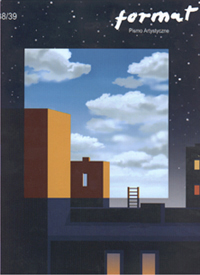Taniec w ciemności w świetle fotografii – fotografie Macieja Rusinka
The Dance of Darkness. On Photographs by Maciej Rusinek
Author(s): Marianna MichałowskaSubject(s): Photography
Published by: Akademia Sztuk Pięknych im. Eugeniusza Gepperta we Wrocławiu
Keywords: Maciej Rusinek; European Ausdrucktantz and pantomime; Butoh performance; spectacle of light; the avant-garde tradition of film-makers; Murnau; Lang
Summary/Abstract: Japanese ideogram “butoh” includes two elements: bu, meaning dance, and toh, meaning pace. “Antoku butoh” means “the dance of darkness”. Maciej Rusinek’s photographs refer to that ideogram, but, in his pictures, the dance of darkness becomes the dance of light. His pictures are filled with light. Dance reveals energy, and Rusinek’s photographs show the energy hidden in the human body. Butoh originated from the spirit of the 20th century avant-garde. Kazuo Ohno and Tatsumi Hijikata combine the experience of Oriental theatre (kabuki, no) with the European Ausdrucktantz and pantomime. In 1959, butoh performance was considered scandalous because it didn’t follow the traditional style, but, rather, it tried to change the tradition. The butoh artists improvised and produced completely new dance language. There is a way of capturing the trace of the butoh on film. It is possible to tell the story of that original performance, and the dancers don’t have to do anything special but show their art to the artistphotographer. Anton G. Bragaglia wrote in his “Photodynamism Manifesto” that photography could capture inexpressible and notangible aspects of the reality. When a movement begins, we cannot realize how it will look. Photographs document the movements. They capture endurance and fugitiveness. Rusinek’s photographed the butoh dancers and he managed to capture their movements. He showed the transcendental movement which emanates from the human body. The artist used such methods as long and double exposure. His pictures can considered as the spectacle of light. In his photograph entitled “Shihimon”, a figure steps out of the wall. In “Musaki Iwana”, a translucent figure is shown in a narrow street. In “Kijima”, a small silhouette is surrounded by a giant shadow. Rusinek follows the avant-garde tradition of such film-makers as Murnau and Lang. He showed the metamorphosis of a dancer, who turned a demon, and then a dragon. He suggested that in one person, there are a few personalities. In his photos, the human figure can split, and, after a moment, it unifies with another self. Daisuke Yoshimoto’s portrait resembles the 19th century symbolic photos: the human figure is shown standing motionless, but, the posture reveals ready-to-burst energy. Still figures aren’t stationary. Rusinek knows how to show the perfect beauty of gesture and movement.
Journal: Format - Pismo artystyczne
- Issue Year: 43/2003
- Issue No: 03+04
- Page Range: 092-095
- Page Count: 4
- Language: Polish

